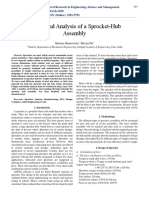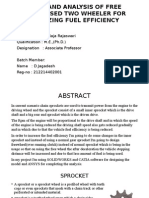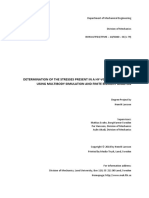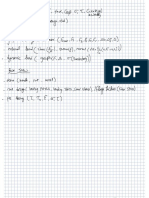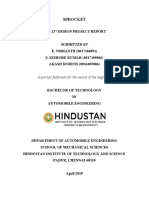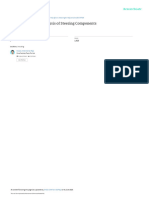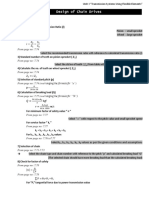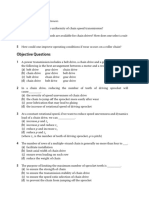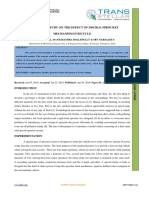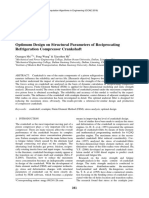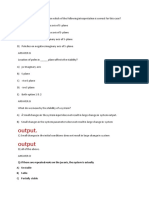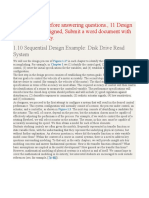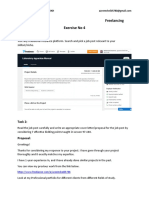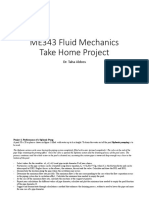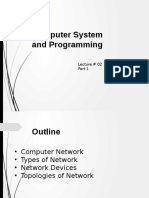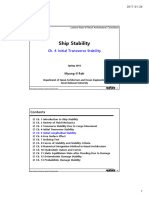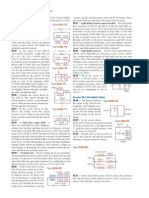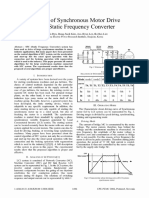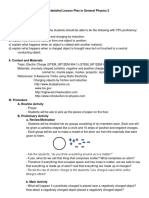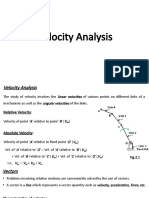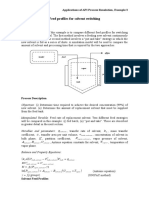Parag Nikam. Int. Journal of Engineering Research and Application www.ijera.
com
ISSN : 2248-9622, Vol. 6, Issue 9,(Part-5) Sepember.2016, pp.66-69
RESEARCH ARTICLE OPEN ACCESS
Design Optimization Of Chain Sprocket Using Finite Element
Analysis
Parag Nikam1, Rahul Tanpure2
1&2
Department of mechanical Engineering, Smt. Kashibai Navale College of Engineering, Pune, India.
ABSTRACT
Chain sprocket is one of the important component of chain drive for transmitting power from one shaft to
another. To ensure efficient power transmission chain sprocket should be properly designed and manufactured.
There is a possibility of weight reduction in chain drive sprocket. In this study, chain sprocket is designed and
analysed using Finite Element Analysis for safety and reliability. ANSYS software is used for static and fatigue
analysis of sprocket design. Using these results optimization of sprocket for weight reduction has been done. As
sprocket undergo vibration, modal analysis is performed.
Keywords: Chain sprocket, FEA, Static analysis, Fatigue analysis, ANSYS
I. INTRODUCTION the FEA are used further for optimization of the
In an automotive vehicle, engine produces component for weight reduction. The modified
the power which is transferred to the drive shaft. design also re-analysed before finalization. ANSYS
Chain drive is one of the commonly used drive software is used for FEA analysis of sprocket. This
train to transfer this power. Chain assembly consist design of the sprocket has been experimentally
of chain, driving sprocket and driven sprocket. The validated after actual implementing on vehicle and
driving sprocket is connected to engine output rigorous testing of vehicle. Further sprocket design
shaft, which transfer power to driven sprocket by tested for vibrations, because vibrational forces
chain. Further this driven sprocket transfer power also plays vital role in sprocket design. Modal
to drive shaft. Therefore in chain assembly driving analysis ensures that resonance frequencies of
sprocket has a chance for design and optimization sprocket are out of Operating range.
for weight reduction. Due to high power transfer
and high speed of rotation, high stress induces in II. CALCULATIONS
sprocket teeth, also high speed leads to the The formula used to calculate the force on each
vibrations. Hence it is important to designand tooth of the sprocket is
manufacture sprocket properly, also mounting of
sprocket is important. Tk = T0 *(sin φ / sin(φ+ 2)^k-1
While transferring power from driving to
driven sprocket, chain exerts high load on sprocket Where:
teeth.So, maximum loads acting on teeth are Tk= Back tension at tooth k
calculated.Stress induced due to load should be less T0 = Chain tension = 6572.68N
than the yield stress of the material. If stress φ= Sprocket minimum pressure angle
becomes more than yield stress of material then 17 – 64/N = 15.57o
there is a possibility of failure. Hence static N = Number of teeth on driven sprocket = 45
analysis was performed to ensure that the proposed 2β= Sprocket tooth angle (360/N) = 8
design has factor of safety greater than one. Also K = the number of engaged teeth
due to cyclic load acting on the sprocket from = (angle of wrap *N/360) = 15
chain, it is important to test the sprocket for fatigue
loading. In fatigue analysis fatigue life of sprocket The general recommendation is to use
is calculated and it is ensured that the minimum 1/3.5 of the allowable tension as the back tension
fatigue life is higher for safe use of sprocket for (Tk).
sufficient time period. After the minimum fatigue The maximum chain tension will act on
life, crack in the component initiated, which further the first teeth and then it decreases continuously. It
increases with time and leads to failure of is assumed that force acting after 10teeth is
component. Therefore it is important for any negligible.
component to have sufficient fatigue life.
FEA is used to perform the static analysis By above method we can calculate forces on 10
and fatigue analysis of component.This ensures the consecutive teeth as follows:
safety and reliability of component. The results of
www.ijera.com 66|P a g e
�Parag Nikam. Int. Journal of Engineering Research and Application www.ijera.com
ISSN : 2248-9622, Vol. 6, Issue 9,(Part-5) Sepember.2016, pp.66-69
Tooth number Force (Newton)
T1 1177.9
T2 1251.9
T3 846.16
T4 567.99
T5 381.27
T6 255.9
T7 171.79
T8 115.31
T9 77.4
T10 51.96
Fig.1 Forces
III. MATERIAL SELECTION
Material selection is important
consideration, due to strength and weight of Fig.3 Von-mises stress plot
sprocket. Mild steel was used to ensure sufficient
strength of component.
Properties of mild steel
Young’s Modulus = 2* e^11 Pa
Poisson’s Ratio = 0.3
Density = 7850 kg / m^3
IV. PRELIMINARY DISIGN
CAD model with required dimensions and
standard specifications was created in Solidworks
15.
Meshing tool in ansys workbench was
used to create a very fine mesh with element size
1.5mm.
Fig.4 Deformation plot
Maximum Von-mises stress according to
plot is 179.08Mpa. The maximum value of stress is
less than the yield stress of mild steel, which results
in factor of safety greater than 1.While Maximum
deformation obtained is 0.01831mm. This
maximum deformation appears at point which is
subjected to maximum force.
The above stress and deformation plots
used for removing material for optimization.
b) Fatigue Analysis
Fatigue analysis was performed to
Fig.2 Meshing calculate the fatigue life of sprocket. The first
evidence of crack obtains after the minimum
a) Static Analysis fatigue life. Hence it is important considering
Calculated forces are applied on teeth fatigue life for component design.Fatigue tool from
surfaces with direction tangential to pitch circle of ANSYS Workbench was used for fatigue life
sprocket teeth. Also fixed constraints are applied at calculation. Stress-life (S-N curve) analysis was
bolt holes. Analysis was done in Ansys Workbench performed;zero based force with goodman mean
16.0. stress theory was used for high accuracy of result.
Plots showing von-mises stress and
deformation are as follows:
www.ijera.com 67|P a g e
�Parag Nikam. Int. Journal of Engineering Research and Application www.ijera.com
ISSN : 2248-9622, Vol. 6, Issue 9,(Part-5) Sepember.2016, pp.66-69
Fig.5 Fatigue life plot
From the above plot, the minimum fatigue Fig.8 Deformation plot
life comes more than e^5 cycles, which is very
high and can be considered safe for practical From above plots it is seen that due to
application. modification, total deformation of sprocket was
increased to 0.0564mm. which is still negligible.
V. MODIFICATION This also results in reduction of von-Mises stress to
By using results of analysis of preliminary 169.04MPa. Hence modified design was under
design optimization for weight reduction was done. safety limit with successful weight reduction.
Material removed such that it does not affect the
performance and safety of sprocket. b) Fatigue Analysis
The modified sprocketalso fine meshed in Similar to preliminary design, fatigue
ANSYS Workbench and further analysed. analysis of modified sprocket was done to calculate
the fatigue life of sprocket. Which again should be
sufficiently high.
Fig.6 Modified model mesh
VI. MODIFIED DESIGN
a) Static Analysis
Loading conditions and boundary Fig.9 fatigue life plot
conditions for modified sprocket kept constant.
Von-Mises stress and deformation for modified Hence from above fatigue life plot
sprocket comes as follows: minimum fatigue life was in range of e^5 cycles,
which is sufficiently high. Therefore, modified
design was safe to use.
VII. MODAL ANALYSIS
Due to very high speed of rotation, chain
sprocket is subjected to very high vibrational
forces. Hence vibration analysis is important factor
in sprocket design for safety. Modal analys was
performed to calculate natural frequencies and
mode shape of both preliminary and modified
sprocket. Mode shape obtained for both the
designwas same but natural frequencies differ.
Fig.7 Von-mises stress plot
www.ijera.com 68|P a g e
�Parag Nikam. Int. Journal of Engineering Research and Application www.ijera.com
ISSN : 2248-9622, Vol. 6, Issue 9,(Part-5) Sepember.2016, pp.66-69
Natural frequencies for both preliminary and
modified design compared as follows:
Frequency Preliminary Modified
design (Hz) design(Hz)
1 1665.5 1024.6
2 1679 1041.8
3 1774.5 1114.4
4 1883.5 1229.3
5 1970 1286.1
6 2492.6 1807.3
Fig.10 Comparision of natural frequencies
It is observed that natural frequencies for
modifies sprocket are less than that of preliminary
sprocket design. The amplitudes of free vibration at
a particular frequency are more for the preliminary
design and it is lesser for the modified sprocket
design. Therfore the modified sprocket’s response
to free-vibrations is better.
VIII. CONCLUSION
The design of sprocket has been
succesfuly optimized with weight reduction of
15.67%. Also von-mises stress of modified design
is lesser than preliminary design with little increase
in deformation, which ultimately results in the
safety and reliability of design. To further increase
factor of safety of the sprocket different material
with higher strength can be used.
REFERENCES
[1]. The Complete Guid to Chain (U.S.
Tsubaki, Inc., Wheeling, Illinois 1997)
[2]. Saeed Moaveni, Finite element analysis,
theory and application with
Ansys(Prentice-Hall, Inc. 1999)
[3]. V.B. Bhandhari, Design Of Machine
Element (McGraw Hills Education pvt.
Ltd. 1994)
[4]. Rexnord (n. d.). Chain Drive Design: A
guideline to calculating and designing
chain drives with a view to application-
related criteria.
[5]. Ebhota Williams S, Ademola Emmanuel,
Oghenekaro Peter,Fundamentals of
Sprocket Design and Reverse Engineering
of Rear Sprocket of a Yamaha CY80
Motorcycle( International Journal of
Engineering and Technology Volume 4
No. 4, April, 2014)
[6]. Kurt M. Marshek, Mohammad R. Naji,
Analysis of Sprocket Load Distribution
(Mechanism and Machine TheoryVol. 18,
No. 5, 1983)
[7]. Nikravesh, P.E.Computer-aided analysis
of mechanical systems.(Prentice Hall,
Englewood Cliffs 1988)
www.ijera.com 69|P a g e


